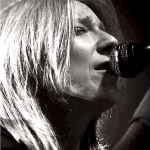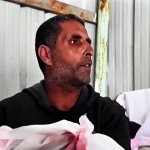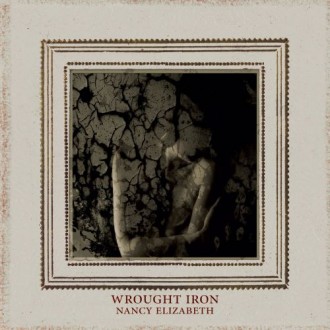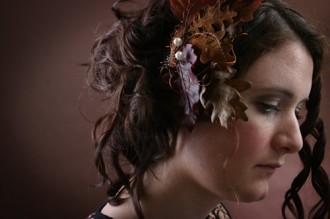Nancy Elizabeth WROUGHT IRON (Leaf)
Nancy Elizabeth (Cunliffe) is a singer-songwriter and instrumentalist from Lancashire, United Kingdom who mixes folk and post-rock influences to make her music. Her first album BATTLE AND VICTORY was released on the Leaf label in 2007. It was all recorded in a 17th century cottage in rural Wales and a village hall on the outskirts of Manchester and features guitars, harp, dulcimers and harmonium amongst other instruments. Her debut EP THE WHEEL TURNING KING was released under her full name Nancy Elizabeth Cunliffe in 2006 on Timbreland. It was all recorded in an old Corinthian style church over two all night sessions taking influences from sources as diverse as European gypsy songs, choral a cappella and North African music as well as more traditional British forms. During 2006 and 2007 her many gigs included supports for James Yorkston, Tunng, A Hawk and a Hacksaw, Marissa Nadler, Espers, The Memory Band and Josephine Foster. Her second full-length album WROUGHT IRON was released in October 2009.
“WROUGHT IRON is made by repeatedly heating and working the raw material with a hammer,” says Nancy Elizabeth of the source of her second album’s title. “This ancient process brings impurities out of the metal, making it stronger, and this was often used to make beautiful and ornate things. I like the analogy of personal adversity and experience being the process of forging, and the pure and strong wrought iron being the end result.”
Elizabeth has taken inspiration from silence and solitude in creating the songs for this album. She has also turned her back on the harp that provided the musical focus for her earlier work. On WROUGHT IRON, she plays most of the instruments herself which include guitar, glockenspiel, vibraphone, and a hundred-year-old Dulcitone, in addition to her main instrument of choice, the piano.
Elizabeth wrote the songs for the album by removing herself from urban life, spending time in the Faroe Islands and rural Spain (prior to recording the album in a remote corner of North Wales). The wide-open spaces inspired her approach to the arrangements. “I wrote many of the songs out in Aragon (Spain) where I was staying in a place with no electricity, so I was really listening to the silence, as well as hearing conversations in a completely musical way - to the rhythm of the words.” She worked on some of the songs on an abandoned piano in a derelict school building in a Spanish village. “When I returned a month later, I found that the school had been demolished. I was lucky they didn’t come along with bulldozers while I was sneaking around playing the piano!” Back in England, she stayed in the Lake District where she found a similar stillness, consequently naming the album’s two instrumental pieces ‘Cat Bells’ (after the hill walkers’ favourite fell) and ‘Cairns.’
“I wrote all these songs in solitude, and the lyrics are quite often based around feelings that I would never express to anyone,” she admits. “The experience I have when listening to music alone is something that is impossible to experience with another. It’s a quiet place when it feels like only you and the sounds you are sharing exist, and this is the place that I came to writing WROUGHT IRON from.”
The album is as much influenced by the minimalism of Arvo Part and Steve Reich as by the choral harmonies of Judee Sill and the bare expression of Leonard Cohen’s early music. Elizabeth explains, “I’m fascinated when I listen to Steve Reich’s work. I love his use of voices, mallet instruments and pianos, and I wanted to bring some of that to the album.”
Portrait By Emily Dennison
It’s quite unusual for artists to realise their stated musical objectives as fully as Elizabeth has achieved here. The opening instrumental track, ‘Cairns’, with the artist’s piano dominating, is a beautiful, melodic and gentle reflection of one of England’s most striking landscapes, The Lake District. It was here that Elizabeth spent time writing in an ambience of silence and solitude. Once can picture ice-cold streams gently meandering between mossy stones, down desolate mountains with Eagles swaying in the wind overhead. It’s music that paints pictures and conveys the emotion of the moment. ‘Bring On The Hurricane’ with its gently brushed guitar chords and drums, subtle piano notes and multi-layered vocals blends restraint with reflection to perfection. The song has a strong folk vibe although the artist’s voice avoids those traditional English folk vocal clichés. It’s a song that charms and calms.
‘Tow The Line’ treads a similar path, though more darkly. The piano notes rise and fall without leaving a splash. The melody is almighty while Elizabeth’s voice weaves in between the piano notes in what is a wonderful musical partnership. It’s an expressive vocal that is also judicially detached, fragile and sincere. ‘Feet Of Courage’ opens in striped-down style with the voice only accompanied by a hand struck drum skin. It’s brief and beautiful. ‘Divining’ sees the return of the piano in the company of subtly blown brass, and muted percussive sounds. This song exemplifies how instruments and voice can coexist separately and together to create the most emotional music. ‘Cat Bells’ is a brief, charming sojourn of bells and keyboard before ‘Canopy’ appears. Here the fragile, intimate vocal is at its most dominant with drama heightened by glorious vocal harmonies. Only later do trumpet and guitar fully reveal themselves as the vocal soars to another place. ‘Lay Low’ is the first upbeat song in this delightful collection. The swaying vocal is accompanied by well-judged hand-claps and wandering, subtle brass that just occasionally breaks cover. There’s a strong folk vibe but it’s combined with pop sensibility and concludes on a (surprising) Tex-Mex brass vibe.
‘The Act’ injects a distinct blues vibe, while ‘Ruins’ is a glacially-paced, intensely contemplative song. It also contains the most assertive piano and vocal passages here and is one of the album’s standout tracks.
When I first listened to this album, its music passed me by almost unnoticed. I then listened to it again when selecting songs for my radio show and immediately play-lsted the first two. I then played the whole album again, and again and again. You see, this album has the power to gradually but surely take you over without you realising it. It’s restrained, sonically diverse, haunting, and deserving of your rapt attention.
4/5
|
|

|

The Joy Formidable |
LATEST GALLERY IMAGES

The Price of Food 
The Invisible Enemy |
|
|



